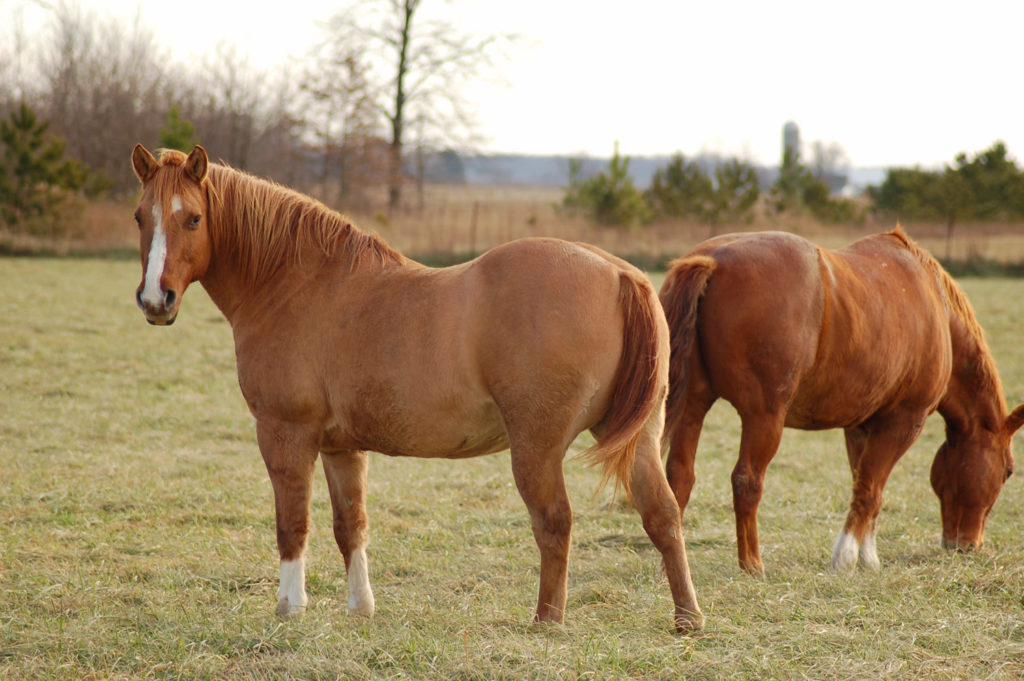
Is your horse obese? Has he been diagnosed with insulin resistance? Does he suffer from intermittent bouts of laminitis? If you answered ‘yes’ to any or all ofthese questions, your horse might be suffering from equine metabolic syndrome (EMS).
But, says equine researcher Ray J. Geor, BVSc, PhD, Dipl. ACVIM, pro vice-chancellor of the Massey University College of Sciences, in Palmerston North, new Zealand, identifying EMS and taking steps to manage the disorder can allow your horse to live a healthy and productive life.
How to Identify Horses with EMS
Geor explained that the endocrine/metabolic disorder EMS can be defined as “increased adiposity (fat deposits), insulin resistance, and a predisposition to laminitis,” but the disorder appears to manifest itself in several different ways. He added that EMS research is ongoing, and researchers are currently exploring the possibility of different subtypes of EMS.
Veterinarians will diagnose EMS on the basis of history, findings from clinical examination, and the results of blood tests and radiographs of the feet (checking for evidence of subclinical laminitis), but obesity, insulin resistance, and laminitis—especially in combination with one another—are strong indicators of EMS.
“An episode of laminitis is often the first clue in identifying EMS,” he said. “It tends to be an insidious (slow) onset, and there may be a history of recurrent episodes.” In pastured horses, episodes of laminitis are often associated with seasonal changes in grazing conditions. Other recent changes in diet (e.g., introduction of new feed) also might trigger laminitis in EMS horses, he added.
Increased adiposity also could point to EMS. Geor says that both generalized adiposity (displayed as general obesity, or a body condition score greater than 7 out of 9) and regional adiposity (generally on the crest of the neck, behind the shoulder, on the tailhead, or on the prepuce and mammary regions) can be indicators of EMS.
Geor cautioned that not all obese horses actually have EMS and that not all horses that have EMS are obese. He explained that more research is needed to fully understand the variation in body types of affected horses, indicating that a different subtype of EMS might be responsible for the disorder in non-obese horses.
Finally, Geor said that insulin resistance is the third indicator that a horse might be affected by EMS. Insulin regulates the glucose concentration in the blood and stimulates glucose storage in tissues. EMS horses, however, will have a decreased tissue response to insulin in addition to increased insulin secretion, resulting in high insulin concentrations in the blood.
The combination of these clinical signs generally leads to a horse being diagnosed with EMS. There are other diseases that could be plaguing the horse, however, and Geor stressed the importance of ruling out other endocrine disorders, especially equine Cushing’s disease.
Managing Horses with EMS
Many horses and ponies affected by EMS can be successfully managed such that the frequency and/or severity of further laminitis episodes is reduced. However, Geor noted that the prognosis is less favorable for horses or ponies that have had multiple previous bouts of laminitis and have suffered major structural damage to hoof laminae. This emphasizes the importance of early EMS detection and management.
Geor cites managing the horse’s diet as one of the most important tasks in controlling EMS. Reducing the body weight of an obese horse is essential for managing the disorder, he said. He suggested several tips to help fuel weight loss in EMS horses:
- Decrease daily calorie intake but maintain a reasonable feed intake to prevent excessive boredom;
- Feed late maturity hay;
- Do not feed grain or sweet feed, and avoid feeding treats;
- Do not turn the obese horse or pony out on pasture, as this results in uncontrolled calorie intake; and
- Feed a small amount of ration balancer feed to meet the horse’s nutrient needs (generally a pound or two per day for an adult horse).
He added that hay should be fed as a percentage of the horse’s body weight (generally starting at 1.2% to 1.3% for weight loss purposes) and should be weighed to avoid overfeeding. Geor added that the nonstructural carbohydrate content of the hay (starch plus ethanol soluble carbohydrates) should be less than 10%.
With effective weight loss, Geor said that insulin resistance will likely improve as well. He suggests monitoring the blood serum insulin concentration as the weight loss program progresses to evaluate progress in that area as well.
Some EMS horses are able to have limited access to pasture after effective management of obesity and insulin resistance, providing there is no current evidence of laminitis. However, owners should control their grass intake. Geor favors use of a grazing muzzle for these horses.
Physical exercise is also suggested to help manage EMS, however Geor said this can be difficult in horses with foot damage due to laminitis. Providing the horse is sound, physical exercise will assist with weight management by increasing energy (calorie) expenditure.
Geor suggests starting work three to four days per week for about 15 minutes at a time. Gradually increase the time as the horse becomes more conditioned, and try to work on an even and consistent surface, such as a sand arena, he said. Carefully monitor the horse’s feet to assure no signs of laminitis or other problems develop.
For horses that are not sound enough for riding, Geor suggests increased turnout in a drylot (preferably a large one that will encourage activity).
Geor added that veterinarians will sometimes prescribe medications (e.g., levothyroxine sodium) for treatment of severely affected EMS horses, especially in situations where laminitis episodes persist in the face of strict dietary control. These medications should only be used in conjunction with other management techniques. Many nutritional supplements are marketed for use in EMS horses but Geor noted there is little scientific backing for these supplements.


